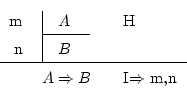Next: 4.5 Implication elimination Up: 4 The derivation rules Previous: 4.3 Conjunction elimination Contents
This is more interesting, since it allows doing something useful with hypothesis (those subdemonstrations which have a vertical bar to the left). It's:

And what it does mean is that if we supposed something (call it ![]() ),
and we just discovered (by using the rules) that supposing
),
and we just discovered (by using the rules) that supposing ![]() made
true
made
true ![]() (whatever it is), then we have something clear: we can't
assure that
(whatever it is), then we have something clear: we can't
assure that ![]() always is true, but we can assure that
always is true, but we can assure that ![]() implies
implies
![]() , which is written
, which is written
![]() .
.
This allows us to end the subdemonstration and continue working with what we were doing before. Remember that you can't finish natural deduction inside a subdemonstration.